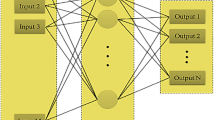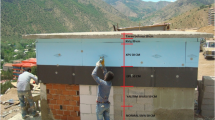Abstract
In this study, we employed the most suitable artificial intelligence systems and optimized it with a novel evolutionary algorithm called particle swarm optimization (PSO) for the problem of cooling load (CL) in energy-efficient building (EEB) system. Then, the mentioned methods are utilised to identify a relationship between the input and output parameters of the EEB system. The amount of CL was taken as the essential output of the EEB system, while the input parameters were channel length, channel depth, channel width, and air mass flow rate. The predicted results for data sets from each of the abovementioned models were evaluated according to several known statistical indices such as correlation coefficient (R2), mean absolute error (MAE), root mean squared error (RMSE), relative absolute error (RAE), and root relative squared error (RRSE) as well as novel ranking systems of colour intensity rating and total ranking method. The M5Rules has been proposed as the best predictive network in this study. The results of the M5Rules network indicated the R2, MAE, RMSE, RAE, and RRSE for the training and testing data sets were 0.9982, 0.0426, 0.0653, 6.2344, and 6.0298 and 0.7626, 0.9903, 0.9593, and 0.9981, respectively. According to R2, RMSE, and VAF, values of 0.99983, 0.0066, and 99.98 and 0.9982, 0.065, and 84.5 were obtained for testing data set and values of proposed PSO-M5Rules prediction network models, respectively. This indicates higher reliability of the introduced PSO-M5Rules model in approximating CL of an EEB system.
Similar content being viewed by others
References
Moayedi H, Mosallanezhad M, Nazir R (2017) Evaluation of maintained load test (MLT) and pile driving analyzer (PDA) in measuring bearing capacity of driven reinforced concrete piles. Soil Mech Found Eng 54:150–154
Moayedi H, Armaghani DJ (2017) Optimizing an ANN model with ICA for estimating bearing capacity of driven pile in cohesionless soil. Eng Comput 34(2):347–356
Torabi M, Hashemi S, Saybani MR, Shamshirband S, Mosavi A (2019) A Hybrid clustering and classification technique for forecasting short-term energy consumption. Environ Progr Sustain Energy 38:66–76
Zulueta YA, Minh Tho N (2018) Lithium hexastannate: a potential material for energy storage. Phys Status Solidi B Basic Solid State Phys 255
Salavati M, Ghasemi H, Rabczuk T (2018) Electromechanical properties of boron nitride nanotube: atomistic bond potential and equivalent mechanical energy approach. Comput Mater Sci 149:460–465
Fallah SN, Deo RC, Shojafar M, Conti M, Shamshirband S (2018) Computational intelligence approaches for energy load forecasting in smart energy management grids: state of the art, future challenges, and research directions. Energies 11
Gao W, Dimitrov D, Abdo H (2018) Tight independent set neighborhood union condition for fractional critical deleted graphs and ID deleted graphs. Discret Contin Dyn Syst S 12(4&5):711–721
Gao W, Guirao JLG, Abdel-Aty M, Xi W (2019) An independent set degree condition for fractional critical deleted graphs. Discret Contin Dyn Syst S 12:877–886
Gao W, Guirao JLG, Basavanagoud B, Wu J (2018) Partial multi-dividing ontology learning algorithm. Inf Sci 467:35–58
Gao W, Wang W, Dimitrov D, Wang Y (2018) Nano properties analysis via fourth multiplicative ABC indicator calculating. Arab J Chem 11:793–801
Gao W, Wu H, Siddiqui MK, Baig AQ (2018) Study of biological networks using graph theory. Saudi J Biol Sci 25:1212–1219
Nilashi M, Ahmadi H, Shahmoradi L, Ibrahim O, Akbari E (2019) A predictive method for hepatitis disease diagnosis using ensembles of neuro-fuzzy technique. J Infect Public Health 12:13–20
Jaafari A, Zenner EK, Panahi M, Shahabi H (2019) Hybrid artificial intelligence models based on a neuro-fuzzy system and metaheuristic optimization algorithms for spatial prediction of wildfire probability. Agric For Meteorol 266:198–207
Jaafari A, Panahi M, Pham BT, Shahabi H, Bui DT, Rezaie F, Lee S (2019) Meta optimization of an adaptive neuro-fuzzy inference system with grey wolf optimizer and biogeography-based optimization algorithms for spatial prediction of landslide susceptibility. Catena 175:430–445
Sadjina S, Kyllingstad LT, Skjong S, Pedersen E (2017) Energy conservation and power bonds in co-simulations: non-iterative adaptive step size control and error estimation. Eng Comput 33:607–620
Deb C, Eang LS, Yang JJ, Santamouris M (2016) Forecasting diurnal cooling energy load for institutional buildings using artificial neural networks. Energy Build 121:284–297
Kaushik A, Vidyarthi DP (2016) An energy-efficient reliable grid scheduling model using NSGA-II. Eng Comput 32:355–376
Rose CM, Bazjanac V (2015) An algorithm to generate space boundaries for building energy simulation. Eng Comput 31:271–280
Almonacid F, Rus C, Perez PJ, Hontoria L (2009) Estimation of the energy of a PV generator using artificial neural network. Renew Energy 34:2743–2750
Almonacid F, Rus C, Perez-Higueras P, Hontoria L (2011) Calculation of the energy provided by a PV generator. comparative study: conventional methods vs. artificial neural networks. Energy 36:375–384
Otanicar T, Dale J, Orosz M, Brekke N, DeJarnette D, Tunkara E, Roberts K, Harikumar P (2018) Experimental evaluation of a prototype hybrid CPV/T system utilizing a nanoparticle fluid absorber at elevated temperatures. Appl Energy 228:1531–1539
Pounraj P, Winston DP, Kabeel AE, Kumar BP, Manokar AM, Sathyamurthy R, Christabel SC (2018) Experimental investigation on Peltier based hybrid PV/T active solar still for enhancing the overall performance. Energy Convers Manag 168:371–381
Shahsavar A, Ameri M (2010) Experimental investigation and modeling of a direct-coupled PV/T air collector. Sol Energy 84:1938–1958
Chen W, Panahi M, Tsangaratos P, Shahabi H, Ilia I, Panahi S, Li S, Jaafari A, Ahmad BB (2019) Applying population-based evolutionary algorithms and a neuro-fuzzy system for modeling landslide susceptibility. Catena 172:212–231
Moayedi H, Mosallanezhad M, Rashid ASA, Jusoh WAW, Muazu MA (2019) A systematic review and meta-analysis of artificial neural network application in geotechnical engineering: theory and applications. Neural Comput Appl 31:1–24
Pham BT, Jaafari A, Prakash I, Bui DT (2018) A novel hybrid intelligent model of support vector machines and the MultiBoost ensemble for landslide susceptibility modeling. Bull Eng Geol Environ 78:1–22
Alsarraf J, Moayedi H, Rashid ASA, Muazu MA, Shahsavar A (2019) Application of PSO–ANN modelling for predicting the exergetic performance of a building integrated photovoltaic/thermal system. Eng Comput 36:1–14
Ghorbani MA, Kazempour R, Chau K-W, Shamshirband S, Ghazvinei PT (2018) Forecasting pan evaporation with an integrated artificial neural network quantum-behaved particle swarm optimization model: a case study in Talesh, Northern Iran. Eng Appl Comput Fluid Mech 12:724–737
Nguyen H, Bui X-N (2018) Predicting blast-induced air overpressure: a robust artificial intelligence system based on artificial neural networks and random forest. Nat Resour Res 29:1–15. https://doi.org/10.1007/s11053-018-9424-1
Nguyen H, Bui X-N, Bui H-B, Mai N-L (2018) A comparative study of artificial neural networks in predicting blast-induced air-blast overpressure at Deo Nai open-pit coal mine, Vietnam. Neural Comput Appl 31:1–17. https://doi.org/10.1007/s00521-018-3717-5
Bui X-N, Nguyen H, Le H-A, Bui H-B, Do N-H (2019) Prediction of blast-induced air over-pressure in open-pit mine: assessment of different artificial intelligence techniques. Nat Resour Res 29:1–21. https://doi.org/10.1007/s11053-019-09461-0
Nguyen H, Bui X-N, Tran Q-H, Le T-Q, Do N-H (2019) Evaluating and predicting blast-induced ground vibration in open-cast mine using ANN: a case study in Vietnam. SN Appl Sci 1:125
Nguyen H, Bui X-N, Tran Q-H, Mai N-L (2019) A new soft computing model for estimating and controlling blast-produced ground vibration based on hierarchical K-means clustering and cubist algorithms. Appl Soft Comput 77:376–386
El-Bendary N, Elhariri E, Hazman M, Saleh SM, Hassanien AE (2016) Cultivation-time recommender system based on climatic conditions for newly reclaimed lands in Egypt. Proc Comput Sci 96:110–119
Bayzid SM, Mohamed Y, Al-Hussein M (2016) Prediction of maintenance cost for road construction equipment: a case study. Can J Civ Eng 43:480–492
Sharma R, Kumar S, Maheshwari R (2015) Comparative analysis of classification techniques in data mining using different datasets. Int J Comput Sci Mob Comput 4:125–134
Holmes G, Hall M, Prank E (1999) Generating rule sets from model trees. Springer, New York
Eberhart R, Kennedy J (1995) A new optimizer using particle swarm theory. IEEE, Piscataway
Huang C-L, Dun J-F (2008) A distributed PSO–SVM hybrid system with feature selection and parameter optimization. Appl Soft Comput 8:1381–1391
Wan S, Yen JY, Lin CY, Chou TY (2015) Construction of knowledge-based spatial decision support system for landslide mapping using fuzzy clustering and KPSO analysis. Arab J Geosci 8:1041–1055
Yaseen ZM, Minh Tung T, Kim S, Bakhshpoori T, Deo RC (2018) Shear strength prediction of steel fiber reinforced concrete beam using hybrid intelligence models: a new approach. Eng Struct 177:244–255
Ho Pham Huy A, Nguyen Ngoc S, Cao Van K, Ho-Huu V (2018) Parameter identification using adaptive differential evolution algorithm applied to robust control of uncertain nonlinear systems. Appl Soft Comput 71:672–684
Moayedi H, Mosallanezhad M, Mehrabi M, Safuan ARA, Biswajeet P (2018) Modification of landslide susceptibility mapping using optimized PSO-ANN technique. Eng Comput 36:1–18
Moayedi H, Moatamediyan A, Nguyen H, Bui X-N, Bui DT, Rashid ASA (2019) Prediction of ultimate bearing capacity through various novel evolutionary and neural network models. Eng Comput 36:1–17
Tsanas A, Xifara A (2012) Accurate quantitative estimation of energy performance of residential buildings using statistical machine learning tools. Energy Build 49:560–567
Alnaqi AA, Moayedi H, Shahsavar A, Nguyen TK (2019) Prediction of energetic performance of a building integrated photovoltaic/thermal system through artificial neural network and hybrid particle swarm optimization models. Energy Convers Manag 183:137–148
Moayedi H, Hayati S (2018) Artificial intelligence design charts for predicting friction capacity of driven pile in clay. Neural Comput Appl 31:1–17. https://doi.org/10.1007/s00521-018-3555-5
Nazir R, Moayedi H, Subramaniam P, Gue SS (2018) Application and design of transition piled embankment with surcharged prefabricated vertical drain intersection over soft ground. Arab J Sci Eng 43:1573–1582
Moayedi H, Hayati S (2018) Modelling and optimization of ultimate bearing capacity of strip footing near a slope by soft computing methods. Appl Soft Comput 66:208–219
Moayedi H, Raftari M, Sharifi A, Jusoh WAW, Rashid ASA (2019) Optimization of ANFIS with GA and PSO estimating α ratio in driven piles. Eng Comput 36:1–12
Gao W, Moayedi H, Shahsavar A (2019) The feasibility of genetic programming and ANFIS in prediction energetic performance of a building integrated photovoltaic thermal (BIPVT) system. Solar Energy 183:293–305
Author information
Authors and Affiliations
Corresponding author
Additional information
Publisher’s Note
Springer Nature remains neutral with regard to jurisdictional claims in published maps and institutional affiliations.
Rights and permissions
About this article
Cite this article
Nguyen, H., Moayedi, H., Jusoh, W.A.W. et al. Proposing a novel predictive technique using M5Rules-PSO model estimating cooling load in energy-efficient building system. Engineering with Computers 36, 857–866 (2020). https://doi.org/10.1007/s00366-019-00735-y
Received:
Accepted:
Published:
Issue Date:
DOI: https://doi.org/10.1007/s00366-019-00735-y












